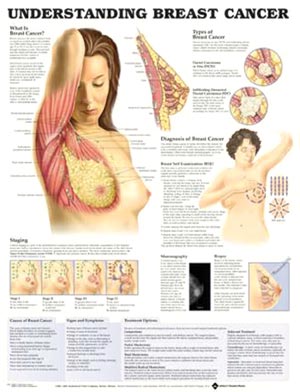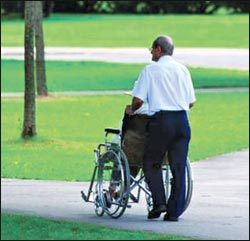|
Health Watch
What all women should know about Breast Cancer
The following article is based on an interview
with Dr. Dilini Samarakoon at the Sri Jayawardenapura Hospital
Breast cancer is an uncontrolled growth of breast cells. The term
‘breast cancer’ refers to a malignant tumour that has developed from
cells in the breast. Usually breast cancer either begins in the cells of
the lobules, which are the milk producing glands, or the ducts, the
passages that drain milk from the lobules to the nipple. Less commonly,
breast cancer can begin in the tissues, which include the fatty and
fibrous connective tissues of the breast.
While we do not yet know exactly what causes breast cancer, we do
know that certain risk factors are liked to the disease. Some risk
factors, such as smoking, and diet are linked to things a person does.
Others, like a person’s age, race, or family history, can’t be changed.
Dr. Dilini Samarakoon who specializes in this disease, stated “While all
women are at risk for breast cancer, the factors listed below can
increase a woman’s chances of having the disease.”

Risk factors
Gender: Simply being a woman is the main risk for breast cancer.
While men also get the disease, it is about 100 times more common in
women than in men.
Age: The chance of getting breast cancer goes up as a woman gets
older. About two out of three women with invasive breast cancer are age
45 or older when the cancer is found.
Family history: Breast cancer risk is higher among women whose close
blood relatives have this disease. The relatives can be from either the
mother’s or father’s side of the family. Having a mother or sister with
breast cancer about doubles a woman’s risk. However it’s also important
to note that 70 percent to 80 percent of women who get breast cancer do
not have a family history of this disease.
Recent use of birth control pills: Studies have found that women who
are using birth control pills have a slightly greater risk of breast
cancer than women who have never used them. Women who stopped using the
pill more than 10 years ago do not seem to have any increased risk. It’s
a good idea to talk to your doctor about the risks and benefits of birth
control pills.
Being overweight or obese: Being overweight or obese is linked to a
higher risk of breast cancer, especially for women after change of life
and if the weight gain took place during adulthood.
Lack of exercise: Studies show that exercise reduces breast cancer
risk. The only question is how much exercise is needed.
One study found that as little as one hour and 15 minutes to 2 1/2
hours of brisk walking per week reduced the risk by 18 percent. Walking
10 hours a week reduced the risk a little more.
Dr. Samarakoon also cautioned women to be aware of the symptoms of
breast cancer which will enable all women to take the necessary
precautions in time.
The symptoms of breast cancer and changes that could occur to the
breast are as follows:
* A lump or thickening in an area of the breast
* A change in the size or shape of a breast - sudden breast size
increase
* Dimpling of the skin
* A change in the shape of your nipple, particularly if it turns in,
sinks into the breast, or has an irregular shape - inverted nipple
* A blood stained discharge from the nipple
* A rash on a nipple or surrounding area
 Itchy red and blotchy: A breast that is red or blotchy, even having a
rash-like appearance should be evaluated by a doctor. It is a symptom of
‘inflammatory breast cancer.’ In this case the whole breast can look red
and inflamed and can be very sore. The breast may feel hard. The skin
sometimes looks like orange peel because the pores stand out in the
inflamed area. Itchy red and blotchy: A breast that is red or blotchy, even having a
rash-like appearance should be evaluated by a doctor. It is a symptom of
‘inflammatory breast cancer.’ In this case the whole breast can look red
and inflamed and can be very sore. The breast may feel hard. The skin
sometimes looks like orange peel because the pores stand out in the
inflamed area.
Breast and surrounding skin can take on a dimpled appearance, looking
like an orange peel. Inflammatory breast cancer is a type of cancer that
is often undected by a mammogram and self breast exam. The red and scaly
rash can be itchy. It looks a bit like eczema and is sometimes mistaken
for that at first.
Many women are too embarrassed to show a doctor, thinking it is
cellulite or from being overweight. This is not the case. It’s normal
for a woman’s breast to become swollen and tender during a normal
menstrual cycle, but when it’s constant, it need to be evaluated by a
doctor.
“Therefore, breast examination should be part of your monthly health-
care routine, and you should visit your doctor if you experience breast
changes. If you’re over 40 or at a high risk for the disease, you should
also have an annual mammogram and physical exam by a doctor. The earlier
breast cancer is found and diagnosed, the better your chances of beating
it,” stressed Dr. Samarakoon.
According to Dr. Samarakoon most breast-cancer-related tests fall
into one or more of the following categories:
Screening tests: Screening tests (such as yearly mammogram) are given
routinely to people who appear to be healthy and are not suspected of
having breast cancer. Their purpose is to find breast cancer early,
before any symptoms can develop and the cancer usually is easier to
treat.
A breast ultrasound is also another method of screening that uses
sound waves to make a picture of the tissues inside the breast. A breast
ultrasound can show all areas of the breast, including the area closest
to the chest wall, which is hard to study with a mammogram.
A breast ultrasound does not use X-rays or other potentially harmful
types of radiation. A breast ultrasound is used to see whether a breast
lump is filled with fluid (a cyst) or if it is a solid lump. An
ultrasound does not replace the need for a mammogram, but it is often
used to check abnormal results from a mammogram.
Diagnostic tests: Diagnostic tests (such as biopsy) are given to
people who are suspected of having breast cancer, either because of
symptoms they may be experiencing or a screening test result. These
tests are used to determine whether or not breast cancer is present and,
if so, whether or not it has travelled outside the breast.
Diagnostic tests also are used to gather more information about the
cancer to guide decisions about treatment. A biopsy is a procedure that
takes a sample of tissue, so that it can be sent for testing by a lab.
It’s important to get accurate results from a biopsy, because if there
is any disease, the biopsy result will help to determine what your next
course of action should be.
The type of Biopsy’s are Fine Needle aspiration. During a fine-needle
aspiration, the surgeon will put a thin needle through the skin and into
the lump. Cells will be drawn into the needle, and given to a
pathologist to look at under a microscope. Needle aspiration might also
be done to determine if the lump is solid or liquid (a cyst).
If the lump is a cyst, after the fluid has been removed, the cyst
will deflate and disappear. If there is no fluid, and the tissue in the
lump is too hard to draw into the needle, then you may need a different
type of biopsy, in order to get the best results.
Core Needle Biopsy: For a core needle biopsy, the surgeon will use a
large, hollow-core needle, which has a special tip. The surgeon puts
this needle through the skin and into the lump.
A very small tissue sample will be taken into the core needle.
Sometimes the surgeon will also use suction, in order to remove a
slightly larger sample of tissue. The sample is then sent for lab tests.
Surgical Biopsy: This surgical technique requires a cut in the skin,
in order to remove a sample of the lump, or sometimes, the entire lump.
An open surgical biopsy will be done in a hospital or surgical centre. A
tissue sample will be surgically removed and sent for testing
immediately.
“In Sri Lanka around 22 percent women are affected by breast cancer
making it one of the commonest cancers amongst women in our country.
Unfortunately out of most women with breast cancer, more than half
aren’t even aware they have it. If detected early and treatment started
right away more than 90 percent of breast cancer patients can become
survivors.
Osteoporosis :
Call for more research and investment
IOF Bone Health Audit identifies that half of
all osteoporotic fractures will occur in Asia by 2050.
A new report into bone health in Asia has called for more education
and investment in preventing osteoporosis in Sri Lanka. The audit of Sri
Lanka’s bone health facilities, resources and capability, has shown that
osteoporosis is vastly under diagnosed, underreported and therefore
often left untreated.
|

Half of all osteoporotic fractures will occur in Asia by 2050 |
The review of 14 countries across Asia was conducted by the
International Osteoporosis Foundation, with the co-operation of local
osteoporosis societies. The findings were released today on the eve of
the World Wide Conference of Osteoporosis Patient Societies in Beijing,
China.
The report found that Vitamin D deficiency and low calcium intake is
prevalent across the countries audited. It also predicted that by 2050,
half of all osteoporotic fractures will occur in Asia.
A recent study presented at the Scientific Sessions of the Nutrition
Society of Sri Lanka in Colombo in 2009 found that 32 percent of
post-menopausal women who were tested for their bone mineral density (BMD)
and their bone mineral content (BMC) had osteoporosis and 45 percent
were osteopenic, or at high risk of developing osteoporosis.
The study also showed that none of the sample group met their
recommended daily intake of calcium, which the World Health Organization
says is around 1300mg per day.
The IOF report highlighted that a major barrier to understanding the
state of bone health in Sri Lanka, was the lack of equipment. There are
four DXA machines and one ultrasound machine, which are used to measure
bone mineral density or quality and diagnose patients with osteoporosis,
available for the whole country. |



